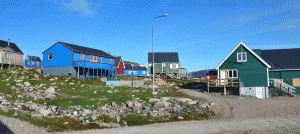(Ben’s story)
After a two-hour flight along the coast through a rainstorm I touched down in the town of Scoresbysund at 01.00 in the morning. I did not know what would happen but I was met by a nurse in a two-seater quad bike and driven straight to the small hospital. The Danish doctor was waiting for me. After unwinding both the bandages and bloody compress he had a look – “nice cut you have there. This might hurt a bit”.
Seven stitches later I began to wonder where I am going to stay. Scoresbysund is tiny, only 400 people, and it was the middle of the night. Luckily the doctor said that he had plenty of room, and I could stay at his house until I got a flight out.
Besides, he already had another patient in “convalescence” – an English visitor who had fallen ill while collecting botanical specimens.
Would my return flight be for Kap Stosch or all the way back to Sweden? The doctor’s response was laconic – “you are OK to keep working, I’ll just show you how to take out your own stitches”.
Looks like I am staying then.
A few phone calls to both our logistics company POLOG, and the SPRS the next morning and it was all sorted. I would join the group again after four days when they moved camp to our next field location on Ymer Island. There we would be looking for evidence of ancient bony fishes and the earliest tetrapod transition from water onto land.

